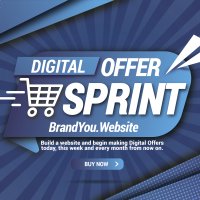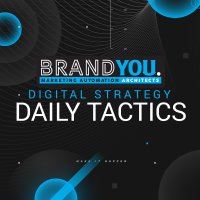Your Digital Strategy is about bringing clarity to all your communications to help tell your brand story in a way that resonates with customers.
Your website should be the home of your brand, so it needs to clearly communicate all of the features and benefits, along with which advantages are most important to your target audience. The best way to ensure the communication is clear is to have a recognized brand story that all internal team members can adhere to when creating content for the web.
In this article, we’ve included strategies for telling your story to current and prospective customers across all channels: websites, sales collateral, and email campaigns. You’ll also see how crafting your brand story in other areas like ads, social media content, and elevator pitches will help customers connect to you.
It's important to have a clear and consistent message. This article will help you figure out what that message should be and how to execute it through your entire marketing process. You'll also learn why some brands fail even with the best intentions, and how you can use this information to avoid this fate as you build your own brand.
Keep it simple. If you want more customers, you need a website that attracts the right ones . . . and keeps them coming back for more.
Some of the most successful websites are beautifully simple. They're clean and uncluttered, with a focus on content and messages that build trust are clear, honest, and direct.
A beautiful website that doesn't say what it needs to say is worse than having no website at all. If we don't communicate well, if the copy is confusing or incomplete, we could be losing sales by the minute.
Good design matters, but "good" needs to be defined in terms of what we're trying to achieve with our website. If we want buyers to reach out to us, then our site should make it easy for them to do so. And, that starts with a clear brand story.
The most effective website headlines or page titles are incredibly short and to the point. You may be wondering how something so short can possibly do the job of telling your visitor what you do or what your company is about. The answer is really quite simple – it's because your headline needs to become memorable. It needs to hit home with your visitor and make them want to read more about you.
Your website has one purpose: to get people to Page 2. If your site isn't doing this for you, then it's failing you. And that means tweaking is in order. You can't have a GREAT website without 5 foundational key components. That's why I'm going to share with you the 5 Key Components of a Perfect Website.
1. An Offer Above the Fold
When you're designing your website, think about the first thing visitors see when they visit your site. That part of the design is called "above the fold" and it's important to get right.
While the term "above the fold" comes from the newspaper industry, it's a useful metaphor for website design. The images and text above the fold are the things you see and read before you start scrolling down. I like to think of the messages above the fold as the "first date" and then as you scroll down, you put the messages you want to share on a second date and third date.
Fixing a problem is the best way to win your audience's trust. They'll be reassured by knowing that you understand what they're going through and have a solution for them.
An offer "above the fold" gives people the feeling that they've found someone who understands them, and the next line should reinforce that feeling. Explain how you solve their problems, or give them a hint of what's coming next (like a preview). It could even be a call to action: "Click here to see our new design."
When you're building an identity for your company, it needs to be:
(1) An aspirational identity promising a better way of doing something, and
(2) It needs to promise that it can solve a problem.
If you're not promising something different, your customers have no reason to look at you. They are bombarded by offers all day long that don't promise anything better or worse than what they have now.
2. Obvious Calls To Action
Every call to action is a chance to earn customers' trust, make sales and increase your conversion rates. By using a direct call to action we allow our customers to purchase our product directly from our website.
The main focus of your page should always be the sales process.
Make it obvious. If a visitor has to search for your call to action button, they're not going to find it.
Make the button large enough that it catches their eye. They should be able to spot it from across the room.
Use a contrasting color so that it stands out against the rest of your site. Visitors shouldn't have to strain to find your call to action button. A call-to-action button on a matching colored background won't stand out at all.
Website buyers scan quickly in a Z pattern across your website, so it's vital to make your calls to action obvious.
The main goal of the web is to get the user from one page to another as quickly and easily as possible.
No matter how beautiful your website is, if it does not answer the needs of your customers, you will lose sales. If you want people to buy, it's best to put a Buy Now button right there on the front page. That's where users are focused.
3. Images of Success
You can tell a lot by looking at pictures.
A picture of a person smiling tells me that they are probably happy. A picture of a person frowning tells me they may not be happy and so on. The same goes for websites.
Use real pictures of your happy customers, not professional models. They are people just like you and me. These customers have come to us for help and we helped them out.
The pictures tell a story of how our customers feel about their life now that they have the product or service we have provided them with. If you want potential customers to see themselves using your product or service, you need to show them doing so with existing happy customers in an image on the website.
This approach showcases your customers. By doing this, you are telling your future customers that "this is what I offer and here is an example of how it will change your life for the better."
If your product can facilitate a lifestyle change, then show it! If you want potential customers to see themselves using your product or service, you need to show them doing so in an image on the website.
If you've been in business for a while, you've probably had at least a few customers or clients express their satisfaction with your products or services. With these customers the best thing to do with this feedback is to share it with potential customers.
Telling potential customers that other people are happy with your product or service can create an immediate sense of comfort and security--it's proof that they can trust you to deliver what they need. And seeing these smiling faces of real people can make your audience feel like they're not alone; It's easier to trust someone when you know that other people trust them as well.
So if you have customer testimonials available, be sure to include them on your website, on your social media profiles, and in any advertisements that you run. Don't just tell customers how great your business is; show them by letting others say it!
4. A Bite Sized Breakdown of Your Revenue Streams
Some businesses have a hard time communicating what they do. Often it's because they are trying to do so many different things that they lose focus on what their core business is.
As a result, they do not provide clarity about what you are offering as successfully as they - nor, their dream customer - would like.
But there is a different approach. Try breaking down your revenue stream into just a few core components and focus on the benefits each part brings. Then hone in on these specific areas as products or services on your website.
What is our business?
How do we make money?
What services do we provide?
Answering these questions is a good place to start when presenting your business.
When we explain our business in bite sized chunks to potential customers, we stand a better chance of converting them. We need to give them enough information to make a decision without overwhelming them.
When you have multiple offers the best way to explain this on your website is by using an umbrella message for your business. This is a single statement - a one liner - that explains what you do and why you're different from your competitors.
If you don't have multiple offers within your company, it may seem like there isn't much of a point in creating an umbrella message. However, even if you only have one service or product, you can still use an umbrella message to help establish trust.
5. Use very few words
People don't read websites anymore. They scan them.
If there's a paragraph above the fold on your website, it's being passed over, I promise. Most of us err too far in the opposite direction. We use too much!
Some of the most effective websites are 10 sentences or less on the entire page. If you do want to use a long section of text to explain something, just place a little "Read More" link at the end of the first or second sentence so people can expand it if they like.
Keep paragraphs relatively short and use subheadings liberally to break up information into chunks that are easier to digest. Use bullet points and numbered lists where appropriate, but be cautious about using them throughout your site because they can become annoying if overused.
Here are a few guidelines to consider:
1. Write only important words — no filler
2. Use subheads, bullets and bolding to break up text into easy-to-read sections
3. Use as few sentences as possible (try for 3 or fewer per paragraph; a good maximum is 5-6)
4. Place your most important point in the first sentence of each section (and make it count; you want readers to see that point and immediately know why they're on this page)
5. Repeat your most important points in the other sections (this repetition is crucial for people to understand what you're trying to say before they leave the page)
There are exceptions to every rule, but in general, keep paragraphs short. Every word you use will have an impact on customer engagement. Don't write for search engines, write for real customers. That means using relevant, actionable content that addresses customer questions and concerns.
Stay on Brand
Your brand story is your Digital Strategy messaging. It is designed to give customers a better understanding of why your brand is different from other brands.
You want your customers to create an emotional connection with your brand and this only happens when the words you use are in alignment with your brand story messaging.
Your customers should not have to wonder if they are on the right web site to find what they are looking for. If you are including messages that don't come from brand story, your website visitors will only hear noise.
There needs to be a consistency among all the communication you do with your brand story messaging. The words need to be from your Digital Strategy messaging. And, it needs to be the same across all communication channels—your website, e-mail marketing and advertising materials.
Need Help?
Schedule a strategy session with Brand You to see how we can help you bring your Digital Strategy to life in your business.




